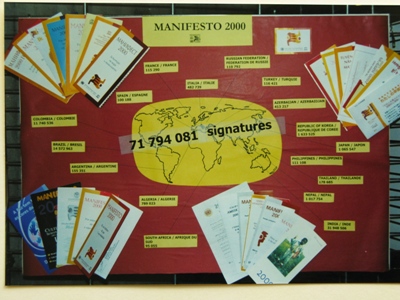Stories
UN Declaration and Programme of Action for a Culture of Peace
Personalities in the "culture of peace bed"
The Manifesto 2000 campaign, which was directed by my Unit for the International Year for the Culture of Peace, was probably the largest mobilization of individuals every undertaken by the United Nations system. Over 75 million people signed the commitment to practice a culture of peace in their daily lives.

The front page of the Manifesto website with the six points of the Manifesto in brief.
The history of the Manifesto 2000 campaign is provided on page 31 of my Early History of the Culture of Peace.
Although the Manifesto was announced in March 1999 and the International Year was launched with great fanfare and publicity throughout the world in September 1999, most of the signatures did not come in until the last month, i.e. August 2000. For one thing, people waited until the last minute to sign, and for another thing, field offices, National Commissions and NGOs waited until the last minute to report their signatures to UNESCO headquarters.
We attempted to have a major event at the United Nations in New York to present the signatures, but the New York office did not come through with the work that was needed, so it passed almost unnoticed at UN headquarters. Ironically, the Millennium Development Goals (MDGs) that were adopted at that time mirrored in most respects the Manifesto (by accident or design I don't know), EXCEPT that the MDGs do not include peace!!

Presentation of the Manifesto at the UNESCO General Conference of 2000
I am sometimes asked if we verified the signatures. Of course, we had to take the word of our partner organizations that they had actually collected the numbers that they said. I rather doubt that the Kenyan National Commission obtained the million that they claimed, but there was no way to call them in question. An NGO in Mexico claimed large numbers of signatures and when they could not be verified, I removed their inputs into our database. On the other hand, we got urgent calls from the National Commission in Algeria, "What should we do with the boxes of signatures. There is not enough room for them here in our offices." Similarly the UNESCO office in Brasilia asked me what to do with their millions. At one point we thought about shipping them to the General Assembly in New York, but it could not be arranged. On my mission to India at the end of 2000, I actually saw the many big cases holding the million signatures that had been collected by the World Peace Center of MIT-MEER (Pune), and I took part in events with Brahma Kumaris that convinced me that their millions of signatures were valid. There is abundant documentation of the millions collected in Korea and Japan, and there was a formal presentation from Japan to the Japanese Director-General in 2000 (see photo on page 29 of the Early History of the Culture of Peace). And as for Brazil, I have seen the fruits for the 15 million signatures collected there in the powerful movement for a culture of peace that it gave birth to.
The question of what to do with boxes of signatures reminded me of what happened at the end of the Peoples Peace Appeal in the 1980's: "A particularly painful moment for me came when Alan and I took scores of heavy cardboard boxes containing the 500,000 American signatures on the People's Peace Appeal and dumped them in the trash." One may conclude that petition campaigns are only as good as the follow-up that can be given to them. In the case of the Peoples Peace Appeal we had tried to follow up with pairings between American and Soviet schools, churches, trade unions, etc., but the crash of the Soviet empire prevented further development. In the case of the Manifesto 2000, the arrival of Hans D'Orville and the new Japanese Director-General in 2000 prevented any effective follow-up by UNESCO. However, I continue to work with many who were mobilized at that time; they were involved in the World Report of 2005 and now in the cities initiatives in Brazil, Spain and Canada reported in the pages of CPNN in 2009.
 |
Stages
1986-1992
Fall of Soviet Empire
1992-1997
UNESCO Culture of Peace Programme